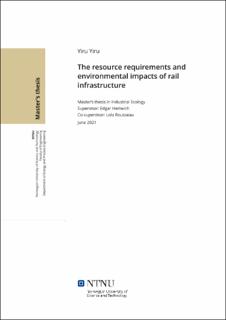| dc.description.abstract | The transport sector is one of the main contributors to climate change. Amongst all types of transport modes, the railway is considered as the greenest one and therefore has been expanded in many countries to decarbonize their transport sector. However, despite the operation of the railway causes less environmental burdens comparing with other types of transports, such as road-based transport, the environmental costs from building railway infrastructure should not be overlooked due to the huge amounts of environmental impacts associated with material/energy production.
This study collected the material and energy intensity data of construction and maintenance stages of three types of railways i.e. high-speed rail (HSR), commuter, and subway to try to build archetypes for each type of railway. The archetypes would be used to estimate the resource consumptions of the railway infrastructure construction and be the basis of the estimation of environmental impacts. The components of railway infrastructure consist of foundation, track system (ballasted track and ballastless track), electrification system, bridges, and tunnels. The data were only collected from literature and documentation, no data were collected from companies due to confidentiality reasons. After collecting the data, pedigree matrices were built to evaluate the data quality. In the end, life cycle assessment was conducted on HSR, and the two other types of railway i.e. commuter and subway were not considered due to the inadequate data.
The main findings from this study are 1) bridges and tunnels are the most material-intensive components; 2) ballastless track consumes more materials, precisely concrete and steel, than ballasted track; 3) concrete, steel, and rubber are the top three contributors to environmental impacts; 4) the main factor influences the uncertainty of the data is completeness, which means lack of data sources causes the uncertainty of data in this study; 5) the environmental studies regarding railways conducted in previous years are mostly about HSR, and other types of rails have not received much attention yet, which leads to lack of information to conduct further studies. | |
